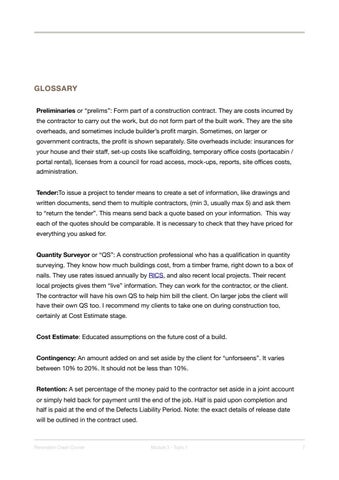GLOSSARY Preliminaries or “prelims”: Form part of a construction contract. They are costs incurred by the contractor to carry out the work, but do not form part of the built work. They are the site overheads, and sometimes include builder’s profit margin. Sometimes, on larger or government contracts, the profit is shown separately. Site overheads include: insurances for your house and their staff, set-up costs like scaffolding, temporary office costs (portacabin / portal rental), licenses from a council for road access, mock-ups, reports, site offices costs, administration.
Tender:To issue a project to tender means to create a set of information, like drawings and written documents, send them to multiple contractors, (min 3, usually max 5) and ask them to “return the tender”. This means send back a quote based on your information. This way each of the quotes should be comparable. It is necessary to check that they have priced for everything you asked for.
Quantity Surveyor or “QS”: A construction professional who has a qualification in quantity surveying. They know how much buildings cost, from a timber frame, right down to a box of nails. They use rates issued annually by RICS, and also recent local projects. Their recent local projects gives them “live” information. They can work for the contractor, or the client. The contractor will have his own QS to help him bill the client. On larger jobs the client will have their own QS too. I recommend my clients to take one on during construction too, certainly at Cost Estimate stage.
Cost Estimate: Educated assumptions on the future cost of a build.
Contingency: An amount added on and set aside by the client for “unforseens”. It varies between 10% to 20%. It should not be less than 10%.
Retention: A set percentage of the money paid to the contractor set aside in a joint account or simply held back for payment until the end of the job. Half is paid upon completion and half is paid at the end of the Defects Liability Period. Note: the exact details of release date will be outlined in the contract used.
Renovation Crash Course
Module 3 - Topic 1
"7






